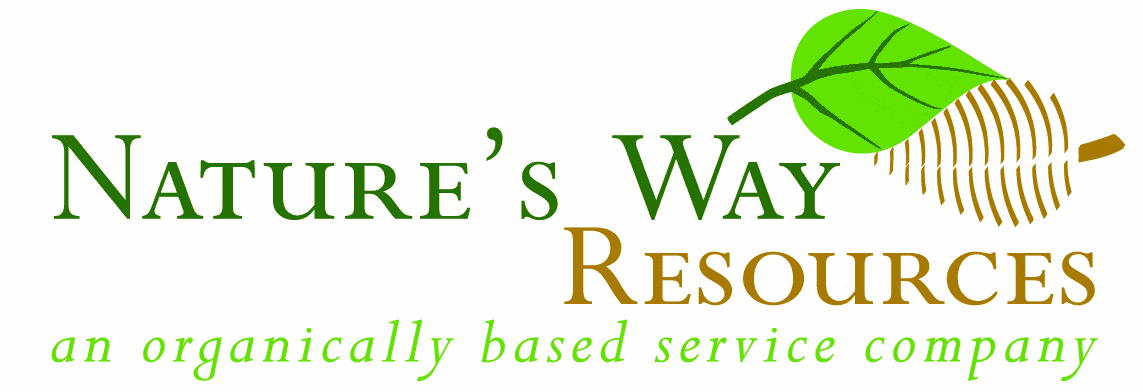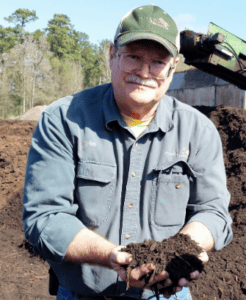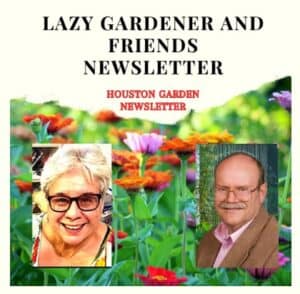 Nature’s Way Resources is proud to produce & email you this free weekly newsletter. We have no ads, but sponsors do graciously help support this project as a public service. Please note their names below & show your gratitude for this free service by patronizing their businesses! To become a sponsor, call (936) 273-1200
Nature’s Way Resources is proud to produce & email you this free weekly newsletter. We have no ads, but sponsors do graciously help support this project as a public service. Please note their names below & show your gratitude for this free service by patronizing their businesses! To become a sponsor, call (936) 273-1200
Nature’s Way Resources owner John Ferguson, “The Lazy Gardener” Brenda Beust Smith and Pablo Hernandez welcome your feedback and are so grateful to the many horticulturists who contribute their expertise
Click here to join our email list
CLICK HERE for PDFs OF PAST LG&F NEWSLETTERS

“Boo-tiful treats for the garden!
BY BRENDA BEUST SMITH
Ready for Halloween? Several readers reported grocery store orange Halloween mums purchased/planted about this time last (!) year are blooming beautifully this fall right on time.
In the right conditions, mums are perennials for us: asking only a well-drained, full sun spot. If they don’t bloom well, they may need to be in a better drained spot and/or more sun. Be sure high nitrogen fertilizers being used on the yard are NOT reaching mums. These promote green growth and inhibit flowering.
After new mum blooms help spiff up your Halloween decorations, plant them in pots or a well-drained spot that gets lots of sunlight. They may (probably will) die back when weather gets too cold. Fear not. They should return in spring. If you can, mulch plants in gardens well with falling leaves. Next spring they’ll sprout and hopefully bloom in both spring and again for Halloween next Fall.
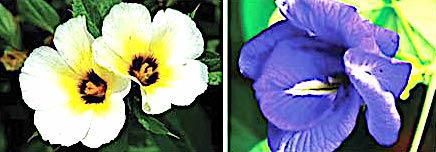
L to r, White Buttercup (Tunera subulata) is bound to be a big draw at Mercer Botanic Garden’s Saturday sale. And – ditto for Butterfly Pea (right, back by demand) at Herb Society of America, South Texas Unit’s 51st Annual Herb Fair. Check out both sales’ posted inventories so you can more efficiently hit both!
TIP O’ THE TROWEL TO PLANT ORGANIZATIONS THAT POST INVENTORIES OF THEIR SALE OFFERINGS! These not only draw in more gardeners, they help educate about which exact varieties do best here. With so many different cultivars now of the same available from so many different national distributers, it’s too easy to get the right general plant but the wrong exact variety for us. In too many cases, it DOES make a difference!

IN OUR SPOTLIGHT ARTICLE BELOW, CLARE FIELDS, Lands Manager for the Native Prairies Association of Texas, guides us into a somewhat-new-to-most-home-gardeners’ relationship between OUR home plantings and our finally-respected prairies. Thinking: WHAT? … Start with: texasprairie.org/why-prairies-matter.
Only 1% (!) of the 6.5 million prairie acres that once covered Texas coast remain. Houston once massive area’s native Gulf Coast prairie has been LOST to development, overgrazing and invasive species.
This is where OUR gardens come in. Our remaining area prairies now regularly HAVE to use prescribed burns for many reasons, one of which is triggered by our gardens . . . to remove common imported plants whose wind-blown seeds are proving invasive, overpowering and stopping growth of natives needed by wildlife (among other reasons). Just be informed! Clare explains below.
A quick note: Although it would prove most helpful, we are not asked at this point to remove well-established prairie-invading plants Clare lists below. What prairie-protecting folks do request: judicious seed-producing pruning. When to prune specific plants? WHEN+TO+PRUNE+TO+STOP+SEED+PRODUCTION (Such knowledge may have many other landscape benefits for you!)
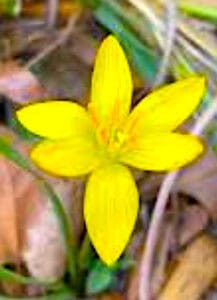 WANT TO GET IN TOUCH with more native prairie plants that LIKE YOUR area? For sites, check Native Prairies Association of Texas. Don’t overlook State parks with prairies and great activities.
WANT TO GET IN TOUCH with more native prairie plants that LIKE YOUR area? For sites, check Native Prairies Association of Texas. Don’t overlook State parks with prairies and great activities.
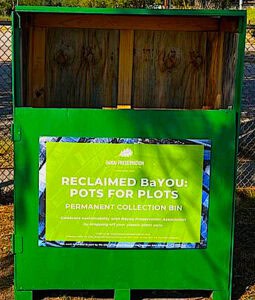 BAYOU PRESERVATIONS’ 3rd POTS FOR PLOTS collection bin is open at Hope Farms, 10401 Scott St. Bins promote sustainability by creating a circular plastic plant pots lifecycle. This bin is open every Saturday during Hope Farms‘ Open Farm/Market Days. Drop off unwanted plastic pots or pick up for your projects. To drop off pots other times, contact Hope Farms: 713-520-0443. Join forces to keep plastic pots out of landfills! — we can make a difference!
BAYOU PRESERVATIONS’ 3rd POTS FOR PLOTS collection bin is open at Hope Farms, 10401 Scott St. Bins promote sustainability by creating a circular plastic plant pots lifecycle. This bin is open every Saturday during Hope Farms‘ Open Farm/Market Days. Drop off unwanted plastic pots or pick up for your projects. To drop off pots other times, contact Hope Farms: 713-520-0443. Join forces to keep plastic pots out of landfills! — we can make a difference!
 PS on GROWING IN DEAD TREE STUMPS: A reader asked about planting cactus? Houston Cactus & Succulent Society’s LILIANA R. CRACRAFT notes it depends on drainage within the core. Logs can hold a lot of moisture in crevices. Dig stump core deeper and, for cactus and other succulents, fill-in with gravel before soil. Drilling holes in sides will help too. A regular mix soil for C&S can be used.
PS on GROWING IN DEAD TREE STUMPS: A reader asked about planting cactus? Houston Cactus & Succulent Society’s LILIANA R. CRACRAFT notes it depends on drainage within the core. Logs can hold a lot of moisture in crevices. Dig stump core deeper and, for cactus and other succulents, fill-in with gravel before soil. Drilling holes in sides will help too. A regular mix soil for C&S can be used.
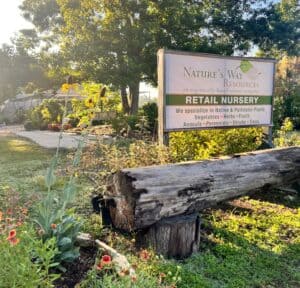 ATTN. GARDEN/PLANT GROUPS — In wake of Hurricane Beryl, Nature’s Way Resources offers free guided tours of NWR’s extensive nursery/soil/mulch facilities for garden clubs, plant societies and other plant-oriented, organized groups. As usual, NWR’s now-expanded meeting site is free to above groups. Reservations a must for both.
ATTN. GARDEN/PLANT GROUPS — In wake of Hurricane Beryl, Nature’s Way Resources offers free guided tours of NWR’s extensive nursery/soil/mulch facilities for garden clubs, plant societies and other plant-oriented, organized groups. As usual, NWR’s now-expanded meeting site is free to above groups. Reservations a must for both.
“LAZY GARDENER’S GUIDE” (PDF format) is emaild free. Request: lazygardenbrenda@gmail.com
Brenda Beust Smith’s column is based on her 40+ years as the Houston Chronicle’s “Lazy Gardener” column — lazygardenerbrenda@gmail.com Brenda’s column focuses ONLY on the Greater Houston Area
Spotlighting…
Native Prairies Association of Texas

L to r: Japanese honeysuckle, Nandina, Chinese privet, Callery/Bradford pear, and Chinese wisteria are among common garden plants now invasive in our area prairies.
HOME GARDENS AND PRAIRIES — LEARNING TO LIVE TOGETHER
BY CLARE FIELDS, LANDS MANAGER
It’s true non-native/invasive plants threaten native ecosystems by outcompeting the native plants and forming monocultures, leading to an overall loss of biodiversity and often irreversible damage to ecosystem structure and function. When we lose plant diversity, which naturally exists in native ecosystems, we lose diversity on every level- soil microbiology, insects, birds, mammals, reptiles, and amphibians, etc.
You are also correct that prescribed fire can be a helpful management tool in managing invasive species. In large scale conservation, we often work to minimize the spread and introduction of invasives when eradicating them is impossible. Prescribed fire will often “top kill” invasive species. While they may not be killed by the fire, they will be impacted enough that native plants are more able to compete with non-natives. In addition to prescribed fire, mechanical removal and chemical treatment are common methods of managing invasive species.
And yes, unfortunately many of our problem species are ones that are still sold commercially as landscape plants. Some common examples of these are Japanese honeysuckle, Nandina, Chinese privet, Callery/Bradford pear, and Chinese wisteria. These seeds are primarily spread by birds and other wildlife.
EDITOR’S NOTE: For events or more info on keeping your yard from threatening prairie wildlife near you: houstonwilderness.org/prairies. To volunteer in on-site activities: houstonwilderness.org/volunteeropps. All these plants named above are listed as dangerously invasive by numerous local and nationwide sources. Texas organizations involved in prairie preservation
John’s Corner
NEWS FROM THE WONDERFUL WORLD
OF SOIL AND PLANTS # 306
Subject: manure-based fertilizers
I was asked a question the other day “What happens if I use manure as a fertilizer? What are the consequences?
Manure has been used as a fertilizer successfully for thousands of years, however manure today is very different.
I have been studying the consequences of the toxic chemical rescue model of industrial farming for 40 years. This failed model is the largest contributor to climate change (many times more than petroleum), most of our human health problems, and many quality-of-life issues.
We have talked about the nutrient side many times in this newsletter and all the harm it does to the soil with repeated usage from salt build up to heavy metals like arsenic in the manure.
Manure based products like poultry manure come from concentrated animal feeding operations (CAFO’s) where chickens, turkeys, hogs, etc. are raised in deplorable abusive conditions. By purchasing the manure, you are helping these companies that are abusing the animals and the environment.
These CAFO’s hurt the people who live near them from air pollution causing asthma and other respiratory problems and poisoning the water they drink. Other hazards are antibiotic resistant bacteria, toxic algae blooms and spreading of global pandemics like bird flu. Note: Poultry are fed antibiotics to help keep the animals alive in toxic conditions and it helps them put on weight faster. These deplorable conditions create a lot of bad stress hormones in the animals, which then ends up in the meat and the manure. When we eat the meat or use their manure with these bad hormones to grow food, many of them are absorbed by the plant and are in our food supply and end up in our bodies, contributing to our health problems.
Factory farms are a major environmental and health issue. For example, a study by the Environmental Working Group (EWG) found almost 357 million chickens and turkeys and 9.6 million hogs were housed on factory farms in just North Carolina (2022).
The Bible in Deuteronomy tells us that cattle are to eat grass and plants from pastures. Meat from grass fed animals has a very different nutritional profile than those from feedlots.
A common practice is using poultry manure being as cattle feed. From the Natural News e-newsletter a few years ago.
What’s really in that burger? E. coli and chicken feces both allowed by USDA by Mike Adams, the Health Ranger, Natural News Editor
“There are 14 billion hamburgers consumed each year in the United States alone. The people who eat those burgers, though, have little knowledge of what’s actually in them. Current USDA regulations, for example, openly allow beef contaminated with E. coli to be repackaged, cooked and sold as ready-to-eat hamburgers.
This simple fact would shock most consumers if they knew about it. People assume that beef found to be contaminated with E. coli must be thrown out or destroyed (or even recalled), but it’s often just pressed into hamburger patties, cooked, and sold to consumers. This practice is openly endorsed by the USDA.
But E. coli may not be the worst thing in your burger: USDA regulations also allow chicken feces (manure) to be used as feed for cows, meaning your hamburger beef may be made of second-hand chicken poop, recycled through the stomachs of cows.
Chicken poop in your burgers?
According to the FDA, farmers feed their cattle anywhere from 1 million to 2 million tons of chicken feces (manure) each year. This cross-species crap-as-food practice worries critics who are concerned it may lead to increased risk of mad cow disease contaminating beef products. So, they want to ban the practice and disallow the feeding of chicken litter to cows.
Now, you might wonder how chicken feces could pose a mad cow infection risk to cows. And if you’re not already grossed out by what you’ve read so far, you will be when you read the answer to this question: It’s because chickens are fed ground up parts of other animals such as cows, sheep and other animals. Some of that chicken feed spills out and gets swept up as chicken litter, then fed to cows.
So now we have a bizarre experiment in animal feed where dead cows, sheep and other animals are fed to chickens, and then chicken feed spills onto the floor where, combined with chicken poop, it gets swept up and fed to cows. Some of those cows, in turn, may eventually be ground up and fed back to the chickens.
Do you see how this might be a problem?”
For those who want to learn more there are several educational videos:
The “Meatrix” is also an excellent educational tool on factory farming. The film broke all records for online advocacy and was seen by millions of people in the first few months alone. There are 3 animated movies on the website on the dangers and cruelty of factory farms and where to buy sustainable products. www.themeatrix.com
Humane Farming Association – HFA’s goals are to protect farm animals from cruelty, to protect the public from the dangerous misuse of antibiotics, hormones, and other chemicals used on factory farms, and to protect the environment from the impacts of industrialized animal factories. HFA’s comprehensive programs include anti-cruelty investigations and exposes, national media and ad campaigns, direct hands-on emergency care and refuge for abused farm animals. www.hfa.org
Factory Farming – Website dedicated to exposing the massive environmental destruction, resource depletion, animal cruelty, and danger of eating meat from factory farms. www.factoryfarming.com
Additional information can be found at: www.farmsanctuary.org
The reasons to grow plants organically and buy organic food increase daily! Organic is more than gardening; it is a lifestyle that protects one family and God’s creation.
SPONSORSHIP
If you are interested in becoming a sponsor, please contact us at 936-273-1200 or send an e-mail to: lazygardenerandfriends@gmail.com
ABOUT US
BRENDA BEUST SMITH WE KNOW HER BEST AS THE LAZY GARDENER . . . but Brenda Beust Smith is also:
- a national award-winning writer & editor
- a nationally-published writer & photographer
- a national horticultural speaker
- a former Houston Chronicle reporter
When the Chronicle discontinued Brenda’s 45-year-old Lazy Gardener” print column — started in the early ’70s as a fun side-project to reporting, it then ranked as the longestrunning, continuously-published local newspaper column in the Greater Houston area. The name, she says, is not just fun, it’s true. Brenda’s gradual sideways step from reporter into gardening writing led first to an 18-year series of when-to-do-what Lazy Gardener Calendars, then to her Lazy Gardener’s Guide book which morphed into her Lazy Gardener’s Guide on CD, which she now emails free upon request. Brenda became a Harris County Master Gardener and, over the years, served on theboards of many Greater Houston area horticulture organizations. She hosted local radio and TV shows, most notably a 10+-year Lazy Gardener specialty shows on HoustonPBS (Ch. 8) and her call-in “EcoGardening” show on KPFT-FM. For over three decades, Brenda served as Assistant Production Manager of the GARDEN CLUB OF AMERICA’S “BULLETIN” magazine. Although still an active broad-based freelance writer, Brenda’s main focus now is THE LAZY GARDENER & FRIENDS HOUSTON GARDEN NEWSLETTER with John Ferguson and Pablo Hernandez of Nature’s Way Resources. A native of New Orleans and graduate of St. Agnes Academy and the University of Houston, Brenda lives in Humble, TX, and is married to the retired Aldine High School Coach Bill Smith. They have one son, Blake. Regarding this newsletter, Brenda is the lead writer, originator of it and the daily inspiration for it. We so appreciate the way she has made gardening such a fun way to celebrate life together for such a long time.
JOHN FERGUSON
John is a native Houstonian and has over 35 years of business experience. He owns Nature’s Way Resources, a composting company that specializes in high quality compost, mulch, and soil mixes. He holds a MS degree in Physics and Geology and is a licensed Soil Scientist in Texas.
John has won many awards in horticulture and environmental issues. For years he represented the composting industry on the Houston-Galveston Area Council for solid waste. His personal garden has been featured in several horticultural books and “Better Homes and Gardens” magazine. His business has been recognized in the Wall Street Journal for the quality and value of their products. He is a member of the Physics Honor Society and many other professional societies. John is the co-author of the book Organic Management for the Professional.
For this newsletter, John contributes articles regularly and is responsible for publishing it.
PABLO HERNANDEZ Pablo Hernandez is the special projects coordinator for Nature’s Way Resources. His realm of responsibilities include: serving as a webmaster, IT support, technical problem solving/troubleshooting, metrics management and quality control. Pablo helps this newsletter happen from a technical support standpoint.
Download the Newsletter with Our Events Calendar Below!
